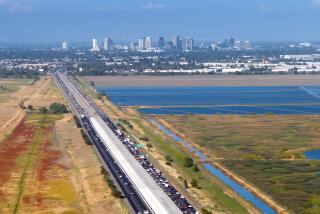Caltrans Brushes Aside Idea to Sweep Freeways at Night
- Share via
Dear Street Smart:
A few weeks ago, I was traveling south from Brookhurst on the Santa Ana Freeway to the Orange Crush to go east on the Garden Grove Freeway.
Too late, I heard on the radio that there was a sweeper train headed south near the Orange Crush.
As I waited to enter from Brookhurst, traffic was backed up as far north as I could see.
I exited at my first opportunity--Euclid--and took surface streets. At Chapman, I could see that the southbound traffic was still bumper-to-bumper.
The next day, I made the same trip and saw that traffic was bumper-to-bumper northbound. Would you believe, a sweeper train was reported to be up around Rosecrans?
I went on and found that traffic was backed up again almost to the Orange Crush.
Isn’t it possible for sweeper trains to do their work at night and not impact so many drivers?
M.E. Elliott
Fullerton
Caltrans sweepers don’t run at night because it is too dangerous for both Caltrans workers and other drivers, agency spokeswoman Maureena Duran-Rojas said.
“Daytime is safer, because people can see them,” Duran-Rojas said. The six sweeper trucks based in Orange County operate every day from 7 a.m. to about 4 p.m.
A given spot on the freeway generally is swept about once a week. Because the sweepers follow a freeway to an end point, then return on the same route going the opposite direction, it is possible that a given freeway could be swept in one direction one day and the opposite direction the next.
And because they only go 5 mph, “it does affect traffic,” she said. “Cars moving in the left lane have to move one lane over to the right, and that causes traffic to slow down.”
*
Dear Street Smart:
I counted 14 burned-out street lights on the transition from the San Diego Freeway north to the Costa Mesa Freeway south and another six on the Victoria Street offramp from the Costa Mesa Freeway south. Do you know why there are so many out in a row?
James Ayres
Costa Mesa
Bad weather and freeway construction are to blame, Duran-Rojas said.
The recent rain and work on various construction projects combined not too long ago to knock out several street-lighting circuits in the area of the interchange of the San Diego and Costa Mesa freeways. The lights you mention should be repaired by the time you read this, Duran-Rojas said. Caltrans crews are continuing to work on others.
The reason so many lights were out in a row, she said, is that several are on each circuit. Circuits are fed by wires in underground conduits which, during bad weather, sometimes admit rainwater that attacks the wires through small faults. The wires then burn, causing the loss of complete circuits.
Faults are often caused by small rocks that find their way into the conduit, Duran-Rojas said, or by rodents and ants that chew on the wires’ insulation. Finding and repairing these faults in hundreds of feet of conduit, she said, can be time-consuming.
*
Dear Street Smart:
Now that the new San Joaquin Hills Transportation Corridor toll road has opened and been in operation for a few weeks, will there ever be large, median-placed offramp informational signs erected to help identify the ramps a few miles in advance?
Many of my friends--and I’ve heard this discussed by residents in the area as well--complain that nonlocal drivers don’t know the different ramps in advance as they drive south into our area. . . . Could you please comment?
Marshall I. Schlom
Aliso Viejo
Placing signs in the median would be dangerous, a spokeswoman for the Transportation Corridor Agencies said.
But the agency and Caltrans officials met last week to discuss adding city destinations to on- and offramp signs to help out-of-towners find their way. That, spokeswoman Michele Sperl-Miller said, “will happen in the near future.”
Some signs are mounted on bridges over the toll road, but not as many as on, say, the San Diego Freeway, because the toll road has fewer bridges and more curves, she said.
There are, however, some signs warning of upcoming ramps on the right-hand side of the road, Sperl-Miller pointed out.
Street Smart appears Mondays in The Times Orange County Edition. Readers are invited to submit comments and questions about traffic, commuting and what makes it difficult to get around in Orange County. Include simple sketches if helpful. Letters may be published in upcoming columns. Please write to David Haldane, c/o Street Smart, The Times Orange County Edition, P.O. Box 2008, Costa Mesa, CA 92626, send faxes to (714) 966-7711 or e-mail him at David.H[email protected]. Include your full name, address and day and evening phone numbers. Letters may be edited, and no anonymous letters will be accepted.
More to Read
Sign up for Essential California
The most important California stories and recommendations in your inbox every morning.
You may occasionally receive promotional content from the Los Angeles Times.










